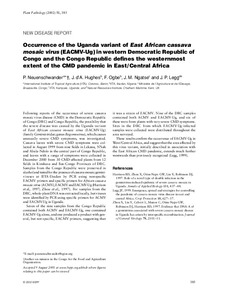| dc.contributor.author | Hodgetts, J. |
| dc.contributor.author | Karamura, G. |
| dc.contributor.author | Johnson, G. |
| dc.contributor.author | Hall, J. |
| dc.contributor.author | Perkins, K. |
| dc.contributor.author | Beed, Fen D. |
| dc.contributor.author | Nakato, V |
| dc.contributor.author | Grant, M. |
| dc.contributor.author | Studholme, David J. |
| dc.contributor.author | Boonham, N. |
| dc.contributor.author | Smith, J. |
| dc.date.accessioned | 2019-12-04T11:03:24Z |
| dc.date.available | 2019-12-04T11:03:24Z |
| dc.date.issued | 2014 |
| dc.identifier.citation | Hodgetts, J., Karamura, G., Johnson, G., Hall, J., Perkins, K., Beed, F., ... & Smith, J. (2015). Development of a lateral flow device for in‐field detection and evaluation of PCR‐based diagnostic methods for Xanthomonas campestris pv. musacearum, the causal agent of banana xanthomonas wilt. Plant Pathology, 64(3), 559-567. |
| dc.identifier.issn | 0032-0862 |
| dc.identifier.uri | https://hdl.handle.net/20.500.12478/1042 |
| dc.description.abstract | Xanthomonas campestris pathovar musacearum (Xcm) is the causal agent of bananaXanthomonas wilt, a major threat to banana production in eastern and central Africa. Thepathogen is present in very high levels within infected plants and can be transmitted by abroad range of mechanisms; therefore early specific detection is vital for effective diseasemanagement. In this study we have developed a polyclonal antibody (pAb) and deployed thisin a lateral flow device (LFD) format to allow rapid in-field detection of Xcm. We alsoindependently assessed published Xcm PCR assays: only two assays gave specificamplification of Xcm, whilst others cross-reacted with non-target Xanthomonas species. Purecultures of Xcm were used to immunise a rabbit, the IgG antibodies purified from the serumand the resulting polyclonal antibodies tested using ELISA and LFD. Testing against a widerange of bacterial species showed the pAb detected all strains of Xcm, representing isolatesfrom seven countries and the known genetic diversity of Xcm. The pAb also detected theclosely related Xanthomonas axonopodis pathovar vasculorum (Xav), primarily a sugarcanepathogen. Detection was successful in both naturally and experimentally infected bananaplants, and the LFD limit of detection was 105 cells/ml. Whilst the pAb is not fully specificfor Xcm, Xav has never been found in banana. Therefore the LFD can be used as a first linescreening tool to detect Xcm in the field. Testing by LFD requires no equipment, can beperformed by non-scientists and is cost-effective. Therefore this LFD provides a vital tool toaid in the management and control of Xcm. |
| dc.format.extent | 559-567 |
| dc.language.iso | en |
| dc.subject | Polyclonal Antibodies |
| dc.subject | Elisa |
| dc.subject | Xanthomonas Campestris Vesicatoria |
| dc.subject | Plant Diseases |
| dc.title | Development of a lateral flow device for infield detection and evaluation of PCR based diagnostic methods for Xanthomonas campestris pathovar musacearum, the causal agent of banana Xanthomonas wilt. |
| dc.type | Journal Article |
| dc.description.version | Peer Review |
| cg.contributor.crp | Roots, Tubers and Bananas |
| cg.contributor.affiliation | Food and Environment Research Agency, UK |
| cg.contributor.affiliation | University of Exeter |
| cg.contributor.affiliation | National Agricultural Research Organisation, Uganda |
| cg.contributor.affiliation | International Institute of Tropical Agriculture |
| cg.coverage.region | Africa |
| cg.coverage.region | West Africa |
| cg.coverage.country | Ethiopia |
| cg.isijournal | ISI Journal |
| cg.authorship.types | CGIAR and developing country institute |
| cg.iitasubject | Plant Diseases |
| cg.journal | Plant Pathology |
| cg.howpublished | Formally Published |
| cg.accessibilitystatus | Limited Access |
| local.dspaceid | 77971 |
| cg.identifier.doi | https://dx.doi.org/10.1111/ppa.12289 |

